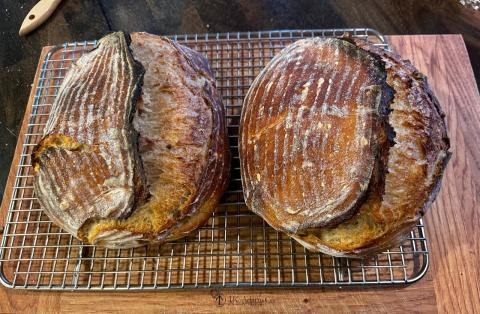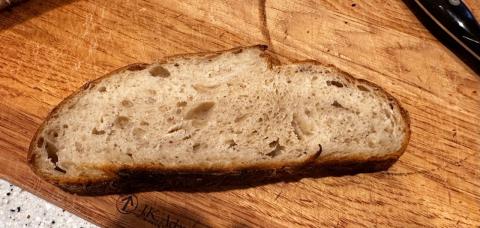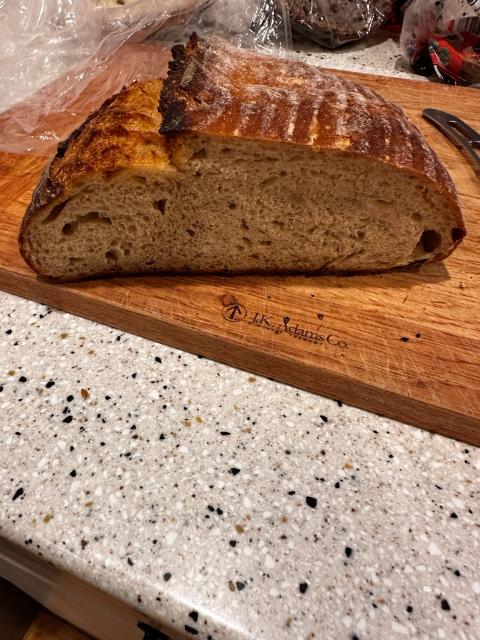
Overnight Country Blonde Question

So I've been pretty successful with the Forkish Overnight Country Blonde recipe using Central Milling Organic Bee Hive APF, Organic Whole Wheat Hi-Pro fine and Central Milling Organic Whole Dark Flour. The texture and taste is outstanding.Moist and spongy . Addicting. But recently with the weather change here in Oregon ( maybe a reason ) I've noticed that after I have divided the dough and begin shaping that one half of it is always stickier and more diffictult to shape. And loses some shape after release from the proofing basket before baking. The other one stays firm and upright. And there is a slight difference in rise. The picture you see is from the loaf that didn't rise as much and was much more difficult to shape. I am very cautious when I take the dough out of the 12 quart cambro container after the 14 hour ferment overnight.
Any suggestions? Appreicate all your help.





My first thought is top vs bottom of the dough from the bulk ferment tub. That's the only place there could be much difference. The top can get a little dried out, and that might have become more so for some reason. The top surface might end up on the countertop side when you get into shaping, and that portion would be easier to handle if the dough overall is on the wet, sticky side.
TomP
Hi Tom - that's a disticnt possibility. The bottom section was indeed the first to be shaped and was the last dough to come out of the bucket. It could also be other things. i'm going to label the stickier dough on the bag I use to proof it. I am finding that the proofing reaches the best at about 3 hours - after that I am gambling with it being over proofed. I am wondering if the stickier dough will proof faster. Need to narrow this down. Appreciate your help.
paul
I'm not sure about proofing faster, but It could do better with different baking schedules - lower temperature, longer time for the sticky one to help dry it out more.
When I get a wet, sticky, stretchy dough that I didn't expect I skip the preform stage and work it more during shaping. That will include stretching the dough way out, probably rolling it up after folding, and even rolling it up a second time from tip to end of the first rolled-up shape. Usually this adds enough strength, and sometimes even more than wanted. Also using a lot of flour during shaping can help.
You also might try uncovering the wet loaf for the last 20 or 30 minutes of proofing.
thanks tpassin
So i have been skipping the preform stage where i shaped the dough into a loose ball and waited 20-30 minutes. I find this dough to be quite strong at this point but found preshaping just decreased proofing time. So with that particular piece of the dough i was able to get it shaped into a batard and held that shape nicely, However - it was sticky on the top at the end and I prefer a nice smooth surface. I believe more flour might help that and create a smoother surface, I am wondering - do you think adding strength improves rise. Usually these loaves produce rise in the oven that seem very similiar but not this time. I am also going to try what you suggested with stretching the dough out some more. Appreciate your help.
I am wondering - do you think adding strength improves rise?
You can get so much strength that it restricts rise during proofing. But it's not that easy to get to that point, especially when you are using some whole wheat and have a sticky dough. If it were to happen, then the scoring would most likely open more dramatically during baking - unless there wasn't enough gas and yeast power left to power a rise during the bake. Or unless the flour were starting to degrade because bulk or proofing went on too long.
But really, the question is why a process that used to work one way is now acting differently. And there is the question of why one part of the dough feels and looks differently. Let me ask some questions that might help feel our way towards an answer-
1. The loaf that opened up the best, was that one much like the ones you used to get?
2. Have you started to use a different sack of any of the flours at the time the change started?
3. Is your starter acting about the same as always?
4. A 3-hour proof seems long to me - not impossible but longish. In the past, how long were you proofing these loaves?
5. Is the temperature in your house different from before? You mentioned the change in seasons, that's why I'm wondering.
6. How much of a rise are you getting during bulk ferment, and is it the same as before?
At this point, and not knowing the answers to these questions, I would suggest, for experimenting, that you try
- Reducing the hydration;
- Shortening the bulk ferment time; even if the dough only rises say 30 to 50% that can be enough (I'm referring to shortening the time at room temperature, not any of the time spent being retarded in the refrigerator);
- Adding the salt before any rest period or autolyse if you have been holding it back up to now (this tends to make the dough tauter and less extensible).
- Covering the top of the dough inside the bulk ferment tub to prevent it from drying out much. I'd try a piece of plastic wrap sprayed or wiped with oil.
Until you have solved the problem to your satisfaction, you might consider a different slashing pattern that could promote more height and less sideways spreading. Here's a picture of a slash pattern that I often use:
rice_starter-1.jpg
rice_starter-2.jpg
Even though it's not what you are looking for right now, a pattern like this might be interesting to try as you work towards a solution.
TomP
Hi Tom,
Thanks for helping me try to figure this out. I'm going to take notes next time on the different steps that are taken in making these loaves. I reflect back and remember pushing the bulk ferment farther than I did in the past. I tend to be conservative in the last hours of the bulk ferment. I tend to go on how much it has risen overnight. Determining what is "almost tripled in size " as the recipe calls can be subjective when estimating it in a large Cambro container. I do have markings that I use to estimate this.
So here's and interesting thought on the starter I use. The night before I take out my Weck starter jar which I keep my starter. The take out 50 grams of it and mix it with 50 grams of Bee Hive, 50 grams of dark rye and 100 grams of 85 degrees water in another Weck jar. I put the top on and let that work its magic until I'm ready to make the large batch levain. Last time I baked I recall making the levain at 11:00 am. I remember starting to use the starter and noticing that its viscosity was greater which probably meant though I am not confident in saying this is that the starter has consumed everything fed to it the prior evening, After 7-8 hours the Levain had risen quite high in the smaller 6 quart bucket - more so than in the past. After the final mix I noticed that the temp of the dough was 79-80 in various parts of the dough. I typically get dough in the 78 range. Another thing that has changed is that after each fold I have been flipping the dough so dough seam folds are down. This was the first time that I've done it after each fold. Regarding salt - I do hold back until final mix. Regarding the proofing I checked at 3:00 hours and using the finger test were probably at their peak. The test revealed a slow return after poking. The oven was already so I put one loaf in the refrigerator and got the other one ready for baking. From my recollection the first one to be taken out of the banneton to bake was fairly upright but not as upright and firm as the one that came out of the refrig after about 50 minutes before it was baked. The second loaf which was in the refrig came out higher in volume but not by much, I gave that loaf away. I wished I had taken a side shot. The loaf on the right is the one that came out last.
So lots to think about and perhaps returning to my previous routines that produced loaves that were nearly the same. I like your suggestions on using plastic wrap and being more conservative on bulk ferment rise.
Thanks !
Paul
FullSizeRender.jpeg
I remember starting to use the starter and noticing that its viscosity was greater which probably meant though I am not confident in saying this is that the starter has consumed everything fed to it the prior evening
Maybe all that rye changes things, but greater viscosity does not indicate (to me) that all the refreshment has been used up. It just indicates that the gluten has become somewhat more organized in the presence of water and time. When a starter gets too old, it starts to thin out, not get thicker.
Anyway, good luck and keep us informed.
TomP
Starter use is relative to the method involved. Important thing is the method. Eventually you will find the balance. Enjoy!
Oops - changed start to starter in first line